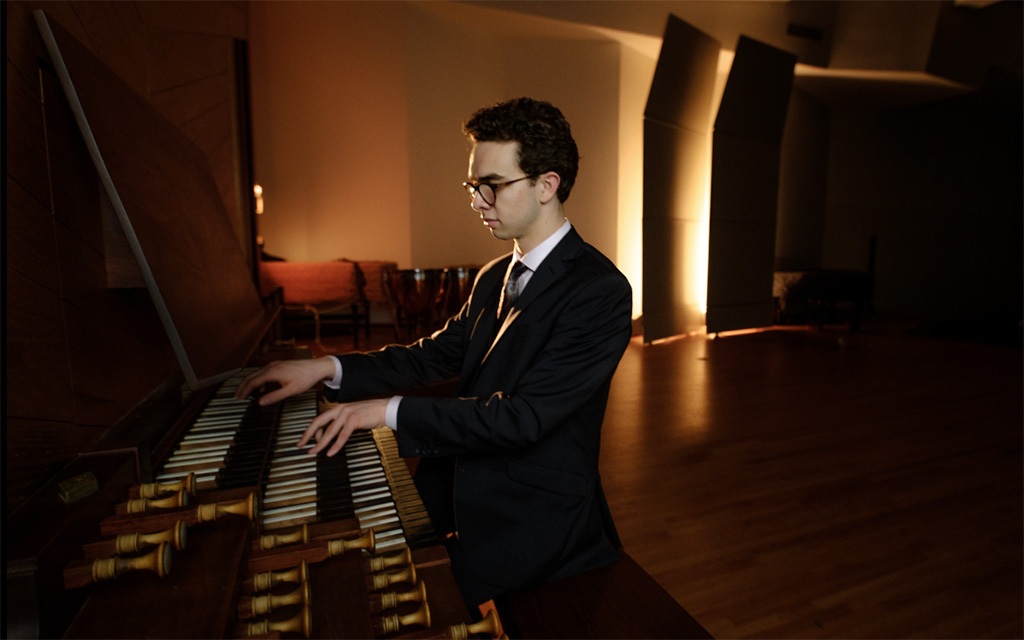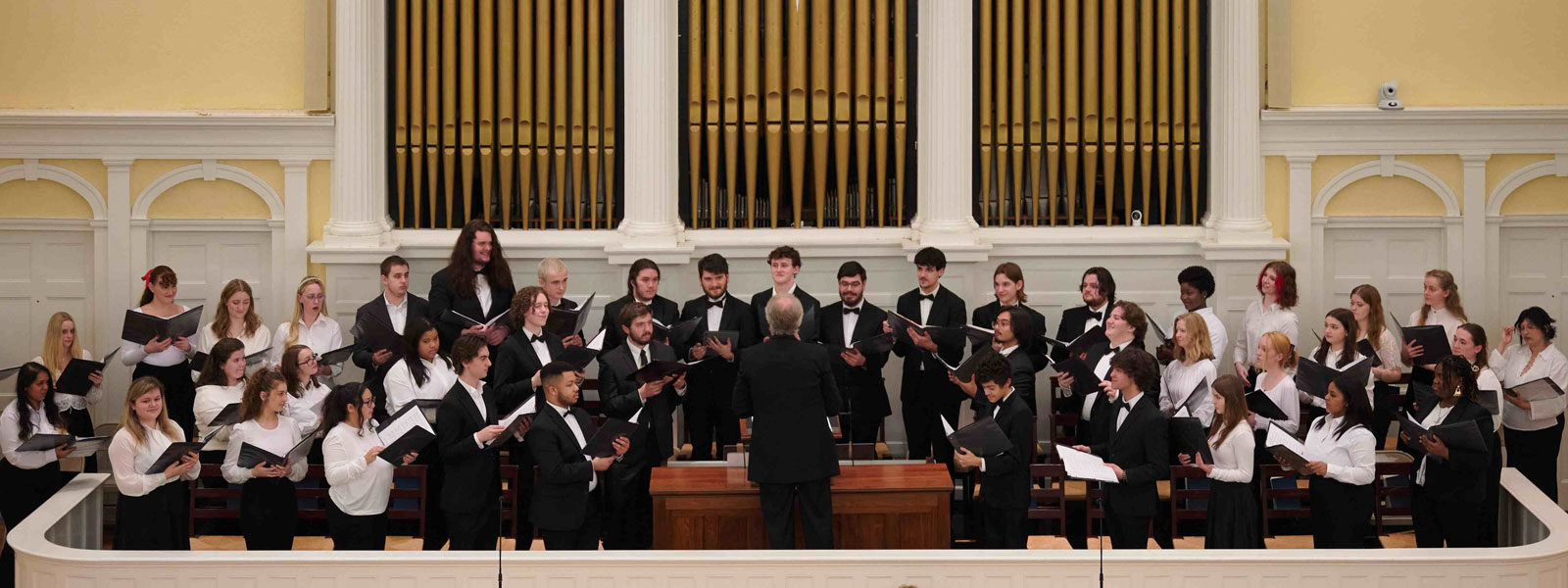UNCSA Symphony Orchestra, Cantata Singers to present Duruflé Requiem and Brass Choir, Organ
The School of Music at UNCSA will present the UNCSA Symphony Orchestra and the UNCSA Cantata Singers in a concert of soul-stirring sacred music on Sunday, Feb. 25, at 3 p.m. at Centenary United Methodist Church, 646 W. Fifth St. The performers will be joined by choirs from Wake Forest University (WFU).
Conducted by faculty member James Allbritten, the Requiem, Op. 9, by French composer Maurice Duruflé, will highlight the second half of the afternoon. The first half of the concert will include three pieces, all featuring brass choirs, and organ on two, conducted by Director of Instrumental Ensembles Mark A. Norman.
Tickets are $20 for adults and $15 for non-UNCSA students with ID and are available at online or by calling the box office at 336-721-1945.
The Duruflé Requiem
“Centenary has been so generous,” Allbritten said. “We’re taking full advantage of the architecture of the church.” The Duruflé Requiem “really utilizes the room,” he explained, with its magnificent church acoustics and the sanctuary’s stone columns and floors.
Some time ago, School of Music Dean Saxton Rose — who is a “great admirer of the work” — had asked if the Cantata Singers could do this requiem, Allbritten said, but it really wasn’t possible in the Stevens Center, now under renovation. “You’ve got to have a good organ … as well as room for a full symphony orchestra and singers,” he explained.
Composer Duruflé was an organist, so the organ figures prominently in this requiem. “Centenary is one of the few venues in Winston-Salem where I would even think of doing this requiem,” Allbritten said. UNCSA Kenan Professor of Organ Timothy Olsen will perform on Centenary’s majestic 1931 pipe organ, which was refurbished in 1963 and has received new additions — including a new console — three times since.
The WFU choirs joining the Cantata Singers are led by Director of Choral Activities Chris Gilliam.
One of the greatest works in the choral repertoire, and Duruflé’s most famous work, the Requiem is a setting of the Mass for the Dead, with echoes of Ravel and Debussy, Allbritten said. It is based on Gregorian plainchant (also plainsong) used in the liturgies of the Western Church prior to the introduction of polyphony.
While few lovers of classical music may have heard of Duruflé (dur-ah-FLAY), Allbritten said, organists certainly have. “His organ works are among the most challenging in the repertoire,” Allbritten said. “Duruflé was very critical of his own work, and only published 14 pieces.”
Dedicated to the memory of his father, Duruflé’s Requiem was composed during World War II and not finished until 1947. More people have probably heard of the Fauré Requiem, Op. 48, which was composed nearly 60 years earlier, Allbritten said.
Duruflé uses the same Latin text as Fauré used, which avoided the anguish of the highly dramatic “Dies Irae” (“Day of Judgment”), Allbritten said. While there are “aggressive” movements in the piece — such as the “Libera me,” when the baritone soloist pleads for deliverance “from the mouth of the lion” — the Duruflé is not “a rafter-shaking work” such as the Verdi Requiem, which Allbritten last conducted about a decade ago.
“Duruflé was more focused on consolation, acceptance and release,” Allbritten said. The work begins with, “Eternal peace, grant unto them, O Lord, and let the perpetual light shine upon them.” “He also includes movements that are not in the liturgical requiem mass, such as 'Pie Jesu' (a prayer to Christ for rest) and the final 'In Paradisum' ('In Paradise')," Allbritten said. That, the composer himself said, marks “the ultimate answer of faith to all the questions by the flight of the soul to paradise.”
The Duruflé will be challenging for the singers as well as the orchestra. “We just finished doing the Donizetti opera ‘Maria di Rohan,’” Allbritten said. “The rhythm is much different. This … is so thoroughly French.” The phrasing of the French language is very different from Italian or German, he explained, demonstrating how he teaches his students. “Exploring repertoire like this is important for both singers and instrumentalists as they mature from talented musicians into artists, able to confront many different styles and not sound the same in all of them,” Allbritten said. “It is a different skill set that they will carry with them” when they graduate and pursue their careers.
The First Half of the Concert
The brass and organ program for the first half of the concert features antiphonal music including the “Grand Choeur (Choir) Dialogue” (1881) by French composer Eugene Gigout — commonly performed during the Advent season; the “Canzon (song) in Double Echo” by 16th-century Italian composer Giovanni Gabrieli; and “Fanfares liturgiques” (“Liturgical Fanfares”) for large brass choir by 20th-century French composer Henri Tomasi.
As with the Duruflé, the first half of the concert will take full advantage of the venue.
Norman described antiphonal music as “kind of like the very first surround sound. It was very popular in the late Renaissance and early Baroque periods when instruments and voices were placed in different locations in a cathedral. The music would be coming at you from all directions, producing a call-and-answer effect.”
Most likely, for the Canzon, the brass choirs will be in Centenary’s two facing balconies, so you’ll be hearing music from three different places (including the organ), Norman said: “It’s challenging to play. We have to determine how far away from each other they can be and still remain together.”
Originally part of Tomasi’s opera “Don Juan de Mañara,” the “Fanfares liturgiques” is “a significant work” consisting of four fanfares that lasts 17 minutes, Norman said.
Why choose these particular works? “Most of them were written to be played in the cathedrals of Europe,” Norman said, “and Centenary is a very large space like the cathedrals where this music was conceived to be played when it was written.
“It makes the program more authentic being in Centenary,” Norman said, plus, they wanted to feature the organ.
“They’re all very standard works for brass,” Norman said. “These are pieces our students need to know. They will perform these for the rest of their lives.”
Additionally, Norman said, “We think that sets up the Duruflé very well for the second half.”
The brass choir will be the Bergstone Brass, named for the late founding horn faculty and brass choir leader Fredrick “Fred” Bergstone. The ensemble is composed of all brass and percussion students. They will be joined by two student organists for the two pieces with organ.
About James Allbritten
Currently music director of the A.J. Fletcher Opera Institute at UNCSA, James Allbritten has served as the music director of the school’s Cantata Singers and Symphony Orchestra, and he was the founding artistic director of the A.J. Fletcher Opera Institute. In 2014, he became the general director of Piedmont Opera, where he currently serves as artistic director and has led critically acclaimed performances. He returned to the classroom during the pandemic and is enjoying leading the Cantata Singers once again.
Allbritten trained at Indiana University under Jan Harrington, Robert Porco and Thomas Dunn. He was fortunate to have worked with some of the greatest names in opera, including Boris Goldovsky, Brian Balkwill, James Lucas, Nicola Rossi-Lemeni, Virginia Zeani, Giorgio Tozzi and Margaret Harshaw.
Allbritten also serves on the faculty of Opera Theatre of the Rockies’ Vocal Arts Festival. He has led performances for Opera Theater of the Rockies, Opera Carolina, the Carolina Chamber Symphony, the Mozart Club of Winston Salem and the Winston-Salem Symphony.
About Mark A. Norman
Mark A. Norman has enjoyed a career spanning over 35 years as a conductor and tuba performer. Director of instrumental ensembles at UNCSA, Norman conducts the Wind Ensemble, the Chamber Winds and the Bergstone Brass. He also serves as the resident conductor of the UNCSA Orchestra, teaches courses in conducting and music entrepreneurship, and leads the graduate conducting program.
Norman is also the music director/conductor of the Piedmont Wind Symphony, which he has conducted in critically acclaimed performances. He has also led the group in producing recordings, including new works by Brian Balmages, John Mackey and Randall Standridge.
Norman previously served on the conducting faculties at the University of Michigan, University of North Carolina Greensboro, University of Wisconsin-Milwaukee, Washburn University and Towson University. He is a former member of several orchestras and was a tuba instrumentalist with the U.S. Navy Band in Washington, D.C.
Get the best news, performance and alumni stories from UNCSA.
SUBSCRIBE TO OUR NEWSLETTERS(OPENS IN NEW TAB)(OPENS IN NEW TAB)(OPENS IN NEW TAB)(OPENS IN NEW TAB)(OPENS IN NEW TAB)(OPENS IN NEW TAB)
February 14, 2024






